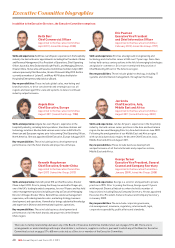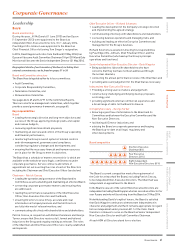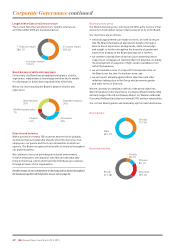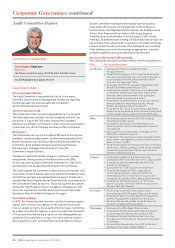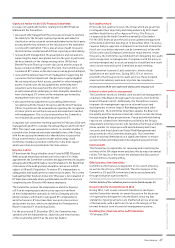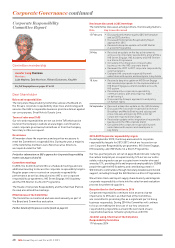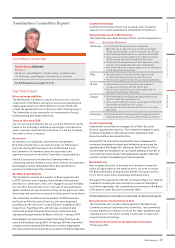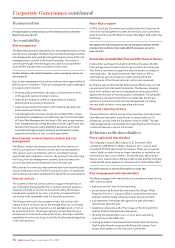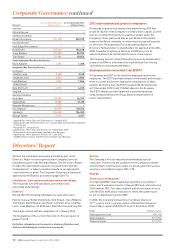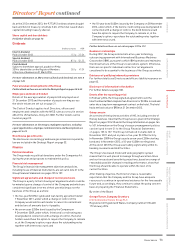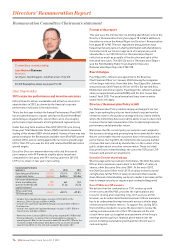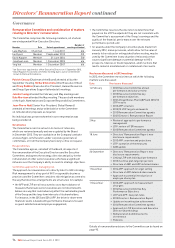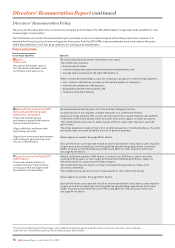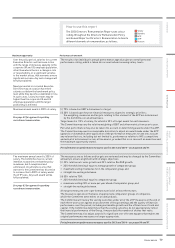Holiday Inn 2013 Annual Report Download - page 72
Download and view the complete annual report
Please find page 72 of the 2013 Holiday Inn annual report below. You can navigate through the pages in the report by either clicking on the pages listed below, or by using the keyword search tool below to find specific information within the annual report.
Remuneration
For information on remuneration see the Remuneration Committee
Report on pages 74 to 97.
Accountability
Risk management
The Board has ultimate responsibility for ensuring that business risks
are effectively managed. The Board has considered and approved the
risk management policy and has delegated regular review of the risk
management procedures to the Audit Committee. The review is
carried out through a monitoring process, which accords with the
Code and the Internal Control: Guidance to Directors.
Further details on the Audit Committee’s role in managing risk are set
out on page 67.
Day-to-day management of business risks are the responsibility of
the Executive Committee. These are managed through established
processes which monitor:
• strategic plan achievement, through a comprehensive series
of Group and regional strategic reviews;
• financial performance, within a comprehensive financial
planning and accounting framework;
• capital investment performance, with detailed appraisal and
authorisation processes; and
• risk management processes relying upon a Major Risks review
and assurance mapping process (through reports from the Head
of Global Risk Management, the Head of GIA, and, as appropriate,
from management) providing assurance that the significant risks
faced by the Group are being identified, assessed, prioritised,
evaluated and appropriately managed and mitigated, having
regard to the balance of risk, cost and opportunity.
Board annual review of internal controls and risk
management
The Board conducts an annual review of the effectiveness of
the Group’s system of internal controls and risk management.
This review covers all material controls, including financial,
operational and compliance controls, the principal risks affecting
the Group, the risk management systems, and also takes into
account any material developments since the year end.
Whilst areas for continuous improvement have been identified and
actions initiated as a result of the Group’s processes, no significant
shortcomings have been identified from the 2013 risk assessments.
Internal controls
The system of internal controls aims to support the delivery of
our strategy by managing the risk of failing to achieve business
objectives and the protection of assets (including the Group’s
brands and reputation). As such, it must be recognised that it
can only provide reasonable and not absolute assurance.
The Group continues to insure against risks, but certain risks
remain difficult to insure, due to the breadth and cost of coverage.
In some cases, external insurance is not available at all, or not at
an economical price. The Group regularly reviews both the type
and amount of external insurance that it buys, bearing in mind the
availability of such cover, its price and the likelihood and magnitude
of the risks involved.
Major Risks register
In 2013, the Audit Committee was satisfied that the Group has an
effective risk management system and the Executive Committee,
Audit Committee and the Board reviewed the Major Risks affecting
the Group.
Our approach to risk management, key risk mitigating activities and the
principal risks and factors that could affect the Group are set out on
pages 34 to 37.
Global Internal Audit (GIA) Plan and Effectiveness Review
In December each year, the Audit Committee discusses the GIA
Plan and approves its nature and scope for the forthcoming year.
This Plan is reviewed on a quarterly basis to ensure coverage of
emerging risks. The Audit Committee then instructs GIA to
undertake an agreed schedule of audits during which the
effectiveness of the Group’s internal controls are assessed.
During the year an internal GIA Effectiveness Review was carried
out and reported to the Audit Committee. The Review contained
input from auditees and senior management and assessed GIA
against the Institute of Internal Auditors Standards. Following the
2013 Review, the Audit Committee concluded that theGroup’s
systems of internal controls and risk management, including
internal audit activities, were operating effectively.
Financial reporting controls
The key financial controls across all our business units have been
identified and evaluated, in particular, to comply with our US
obligations, arising from the Sarbanes-Oxley Act 2002. This has
enabled appropriate representations regarding the effectiveness
ofinternal financial controls to be made.
Relations with shareholders
Share capital and shareholders
The Company’s issued share capital at 31 December 2013
consisted of 268,929,217 ordinary shares of 14194/329 pence each
including 9,773,912 shares held in treasury. There are no special
control rights or restrictions on share transfers or limitations on
the holding of any class of shares. During the year, 604,146 new
shares were issued under employee share plans and the Company
continued the share buyback it commenced on 12 November 2012.
For further details on shareholder profiles see page 180.
Board engagement with shareholders
The Board engaged with shareholders in a number of ways during
2013, which included:
• half-year and full-year formal reporting;
• presentations by Richard Solomons and Tom Singer (Chief
Financial Officer to 1 January 2014) to institutional investors,
analysts and the media following results announcements;
• a programme of meetings throughout the year with major
institutional shareholders;
• telephone conferences after the release of the first and third
quarter interim management statements;
• meeting the shareholders face-to-face and responding
to questions at the AGM; and
• hosting an investor and analyst educational event ‘Delivering
High Quality Growth’ presented by Richard Solomons, Tom
Singer and members of the Executive Committee.
70 IHG Annual Report and Form 20-F 2013
Corporate Governance continued


